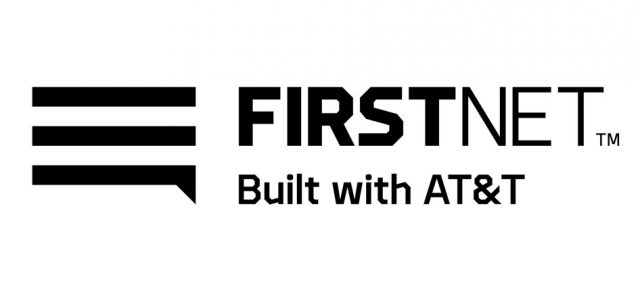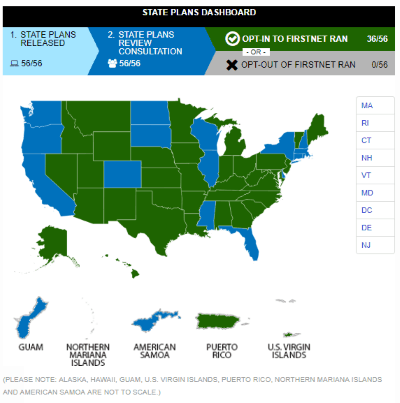 AT&T does not expect to see much initial growth of FirstNet, the government-sponsored first responder wireless network built by AT&T with $6 billion in taxpayer dollars.
AT&T does not expect to see much initial growth of FirstNet, the government-sponsored first responder wireless network built by AT&T with $6 billion in taxpayer dollars.
FirstNet relies on AT&T’s wireless network, bolstered by taxpayer-financed upgrades that will prioritize public safety users during emergencies, but allow any AT&T customer to use the enhanced network the rest of the time. FirstNet has just 110,000 subscribers as of this summer — about a year after launch. AT&T will be expanding FirstNet over the next four years, adding new cell towers, frequencies and bandwidth.
First envisioned after the events of Sept. 11, 2001, the network was designed to allow interoperability between all types of first responders, including law enforcement, fire departments, and ambulance crews. A major complaint after 9/11 was that different public safety agencies could not communicate with each other on the ground because of incompatible radio equipment. FirstNet allows agencies to deploy voice communications and data services on site, without the risk of congestion that occurs on publicly-available cell towers. All FirstNet users are given priority access, and during emergencies, the network will not allow public users to use FirstNet’s network resources.
Seventeen years later, the network is finally launching, but that is proving to be just the first hurdle. To use FirstNet, public safety agencies have to adopt AT&T as their communications provider, sign new contracts, and usually buy new equipment. A surprisingly large number of agencies are balking at changing providers, either because they dislike AT&T, its coverage, the cost, or require a rigorous bidding and procurement process.

AT&T FirstNet rate plans
Rural departments often favor Verizon Wireless, perceived to have better 4G LTE coverage and better performance in rural areas than AT&T. Ray Lehr, formerly with the Baltimore City Fire Department, is now a paid consultant for FirstNet, and admitted AT&T’s rural coverage isn’t as robust as it will be five years from now.
 “Over the next five years, they have to have up to 99 percent rural coverage,” Lehr said. “There’s no reason why another carrier would do that. It just doesn’t make sense.”
“Over the next five years, they have to have up to 99 percent rural coverage,” Lehr said. “There’s no reason why another carrier would do that. It just doesn’t make sense.”
For a lot of rural departments, there are coverage gaps with every wireless carrier and places where there is no coverage from any carrier. Those departments rely primarily on their existing radios for fireground communications and talking with dispatchers.
AT&T is relying on federal dollars to expand FirstNet in places where its own investment dollars are likely not being spent. AT&T also separately receives taxpayer support to build rural fixed wireless networks for consumers out of reach of traditional DSL and cable broadband.
Wall Street, which would ordinarily attack rural investment with no significant return on investment, has had little reaction to AT&T FirstNet, primarily because AT&T will be reimbursed by taxpayers for much of the construction costs, even though AT&T and its retail customers will benefit from the increased coverage and capacity FirstNet will offer most of the time.
“Investors aren’t expecting much, other than the reimbursement for the capital expenditure required to deploy the network,” Jonathan Chaplin, an analyst at New Street Research, told Communications Daily (sub. req’d.). “If public safety usage is low and AT&T can use the capacity for their core mobile users, that is probably fine.”
Other analysts agree, noting AT&T will get all the benefits offering government-paid FirstNet capacity to its retail customers, with none of the risk of losses if first responders do not flock to the new network, because it was not built with AT&T’s money.


 Subscribe
Subscribe The head of a state-funded group with direct ties to the Massachusetts governor’s office told local officials in New Marlborough that the Massachusetts Broadband Institute (MBI) “believes in cable companies” and is favoring one — Charter Communications, with an exclusive offer to invest millions in taxpayer dollars to entice Charter to bring its Spectrum cable service to town, while telling would-be competitors the money is only available to Charter Communications.
The head of a state-funded group with direct ties to the Massachusetts governor’s office told local officials in New Marlborough that the Massachusetts Broadband Institute (MBI) “believes in cable companies” and is favoring one — Charter Communications, with an exclusive offer to invest millions in taxpayer dollars to entice Charter to bring its Spectrum cable service to town, while telling would-be competitors the money is only available to Charter Communications.
 Town resident Dave Travis called Larkin’s offer something else.
Town resident Dave Travis called Larkin’s offer something else. It is rare for AT&T and Verizon to feud in public, even rarer for one company to accuse the other of being anti-competitive, but that is precisely what happened last week in California as the two companies sparred over building a next generation wireless network for first responders.
It is rare for AT&T and Verizon to feud in public, even rarer for one company to accuse the other of being anti-competitive, but that is precisely what happened last week in California as the two companies sparred over building a next generation wireless network for first responders. FirstNet is one of AT&T’s most lucrative contracts in years, and the phone company is doing everything possible to win over state officials in hopes they will embrace the FirstNet plan. It has been a successful effort with more than 30 states, Puerto Rico and the U.S. Virgin Islands purposely opting in, and more than a dozen still studying AT&T’s offer. To date, no state has opted out.
FirstNet is one of AT&T’s most lucrative contracts in years, and the phone company is doing everything possible to win over state officials in hopes they will embrace the FirstNet plan. It has been a successful effort with more than 30 states, Puerto Rico and the U.S. Virgin Islands purposely opting in, and more than a dozen still studying AT&T’s offer. To date, no state has opted out. Verizon’s offer would seem to be a good deal for consumers and governments in states like New York and California that have yet to opt in to AT&T FirstNet, and in California, Verizon was invited to bid to create an alternative network in a potential “opt out” scenario. Verizon’s director of public-safety solutions group – David Wiederecht, promised the state Verizon would submit its bid by the state deadline, which was last Wednesday. By Friday, California officials leaked word Verizon had reneged on that commitment and did not participate, a fact Verizon later confirmed.
Verizon’s offer would seem to be a good deal for consumers and governments in states like New York and California that have yet to opt in to AT&T FirstNet, and in California, Verizon was invited to bid to create an alternative network in a potential “opt out” scenario. Verizon’s director of public-safety solutions group – David Wiederecht, promised the state Verizon would submit its bid by the state deadline, which was last Wednesday. By Friday, California officials leaked word Verizon had reneged on that commitment and did not participate, a fact Verizon later confirmed.







